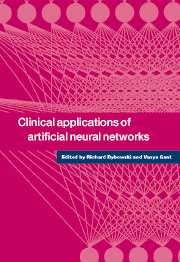Book contents
- Frontmatter
- Contents
- List of contributors
- 1 Introduction
- Part I Applications
- 2 Artificial neural networks in laboratory medicine
- 3 Using artificial neural networks to screen cervical smears: how new technology enhances health care
- 4 Neural network analysis of sleep disorders
- 5 Artificial neural networks for neonatal intensive care
- 6 Artificial neural networks in urology: applications, feature extraction and user implementations
- 7 Artificial neural networks as a tool for whole organism fingerprinting in bacterial taxonomy
- Part II Prospects
- Part III Theory
- Part IV Ethics and clinical prospects
- Index
2 - Artificial neural networks in laboratory medicine
Published online by Cambridge University Press: 06 October 2009
- Frontmatter
- Contents
- List of contributors
- 1 Introduction
- Part I Applications
- 2 Artificial neural networks in laboratory medicine
- 3 Using artificial neural networks to screen cervical smears: how new technology enhances health care
- 4 Neural network analysis of sleep disorders
- 5 Artificial neural networks for neonatal intensive care
- 6 Artificial neural networks in urology: applications, feature extraction and user implementations
- 7 Artificial neural networks as a tool for whole organism fingerprinting in bacterial taxonomy
- Part II Prospects
- Part III Theory
- Part IV Ethics and clinical prospects
- Index
Summary
Introduction
Laboratory medicine is the prime generator of objective data on patients in the medical system. The development of automated analysers in haematology and clinical chemistry has led to the generation of huge amounts of numerical data for each patient and increased sophistication in radiology and histopathology have produced concomitant increases in the informational content of reports (Cross & Bull 1992). This informational explosion in laboratory medicine has led to a great need for intelligent decision support systems to assist the laboratory physicians in formulating their reports and for the clinicians who have to integrate all the laboratory information in the context of an individual patient. It is likely that neural networks will play an increasing role in such support systems given their advantages of model-free estimation, generalization and ability to process nonlinear data (Alvager et al. 1994; Baxt 1994; Su 1994; Dybowski & Gant 1995; Kattan & Beck 1995).
Cytology
Cytological examination entails the examination of preparations, obtained by scraping or fine needle aspiration, in which the predominant feature is the individual cell rather than the whole tissue architecture seen in histological samples. The nature of cytological specimens, with mainly separate cells distributed on a background of plain glass, lend themselves to digitization and thresholding in image analysis systems with semi-automated measurement of features such as nuclear area or densitometry measurements.
- Type
- Chapter
- Information
- Clinical Applications of Artificial Neural Networks , pp. 31 - 80Publisher: Cambridge University PressPrint publication year: 2001
- 1
- Cited by



